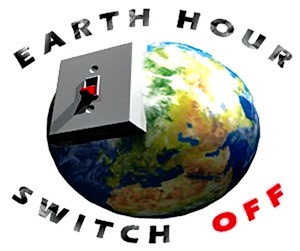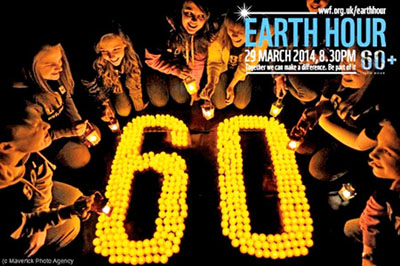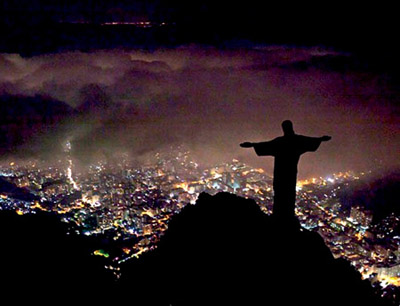|
Earth Hour at 8.30 p.m. on March 29:
Switch off lights to save planet earth
By Carol Aloysius
Come Saturday and the world will plunge into darkness for 60 minutes.
This unusual phenomenon let me hasten to add, is not related to some
alien or extra terrestrial force. Rather, it is distinctly earth based -
a voluntary action triggered off by millions of earth loving men, women
and children to save the further denigration of our planet in a symbolic
gesture to honour the planet on which they live.
 This is not the first time that so many people spanning over 7,000
cities in 152 countries with a digital reach of 200 million, have made
this global gesture to preserve their planet. This is not the first time that so many people spanning over 7,000
cities in 152 countries with a digital reach of 200 million, have made
this global gesture to preserve their planet.
This March will be the seventh year that the world’s largest body of
humanity has come together to protect and save our rapidly shrinking
environmental footprints. If truly committed to the cause, they will
hopefully continue to push towards their goal of preventing the further
eroding and denigration of our planet at least for the sake of our
future generations, using the same Lights Out gesture to motivate humans
everywhere.
Using this Lights Out concept to promote the importance of preserving
our planet, is not something that was conceived haphazardly. It took a
lot of research with the collaboration of scientists who were experts in
this field.
It all started when the World Wildlife Fund (WWF) Australia became
concerned about the increasing levels of toxicity in the earth’s
atmosphere resulting from raised carbon dioxide. The chief culprit they
found was over consumption of electricity both by domestic users and
business organisations as well as by the industrial sector.
History
In 2004, armed with an impressive heap of scientific findings after
their intensive research, WWF Australia met with a leading advertising
agency to discuss ideas as to how they could engage the attention of
Australians on the issue of climate change by showing them the adverse
impacts that global warming had on every living thing that existed on
this planet, which meant of course, people, animals, birds, insects,
plants, seas, rivers, forests and oceans.
 |
The idea of a large scale ‘switch off’ titled ‘The Big Flick’ was
coined in 2006. The idea was ‘sold to the Australian officials, and
received the blessings of Sydney’s Mayor Cover Moore. It was then that
the first Earth Hour was officially launched on March 31, 2007. In
October the same year, another leading city in a different country, San
Francisco in USA, ran its own Lights Out program. Inspired by the
success the events had in the two countries, other cities, towns and
countries followed suit and soon the idea snowballed into something the
world had never seen or expected.
In 2008, it was decided to make it an international event every March
29.
Int’l Day of Forests
To reinforce the significance of saving Mother Earth, another program
with a similar goal was launched last year echoing similar goals and
sentiments. Established by a resolution of the United Nations General
Assembly on November 28 2012, International Day of Forests was launched
and observed for the first time on March 21, 2013.
Both these special Days represented the desperate bid to save our
planet as environmentalists became increasingly alarmed at its rapidly
depleting forests. They revealed evidence of this fact when they showed
how some of the biggest rain forests in the world as in the Amazon had
shrunk by an unbelievable degree leaving indigenous populations who had
made it their habitat, animals that freely roamed within them, flowering
trees that thrived in the erstwhile luscious forests, thousands of
birds, reptiles, insects, and other living species, endangered, fighting
for survival.
The same tragedy is also taking place in our tiny island where due to
unmitigated felling of trees, much of our forest cover has been lost,
dwindling down to less than 20 percent and to shrink even more in the
next 10 years, if the rape of our forests does not cease.
Singharaja, our biggest rainforest is already disappearing along with
millions of the unique wildlife inhabiting it.
Earth Hour celebrations
Earth Hour meanwhile, continues to grab world attention as
celebrities as well as royalty have begun joining in the observances.
The Danish royal palaces Amalienborg Palace and Grasten palace for
example, went dark during a recently held Earth Hour at the Queen’s
command. To promote the earth friendly concept, participating countries
have also carefully chosen sites and locations which are both unusual
and crowd pulling.
In Kuala Lampur, Malaysia, one of the sites chosen was the world’s
tallest twin towers, the Petronas Towers. In Egypt too lights went out
on the Sphinx and the Great Pyramids of Giza for an hour during Earth
Hour.
 |
| Rio de
Janeiro, Brazil |
 |
| Spiderman,
Earth Hour 2014 Ambassador |
Other sites to signal the switching off of non essential lights,
shifted from temples, landmark sites, deserts, to temples and palaces.
To give a few examples, they included: The Sydney Opera House, in
Australia, Empire State Building, New York, USA, Sears Tower (now Willis
Tower), Chicago, Table Mountain, Cape Town, South Africa, the Colosseum,
Rome, Italy, Royal Castle, Stockholm, Sweden, London City Hall, and Wat
Arun Temple, Bangkok.
This year, in a much looked forward to event, Earth Hour will be
promoted by an unusual guest. He is none other than the motion picture
superhero, Spiderman who has been persuaded to serve as an ambassador
for the cause.
Images of the crimson clad superhero climbing walls, standing on high
roofs and clinging perilously on thin wire as he jumps across high rise
buildings rising several storeys to the skies, are already on the Earth
Hour website for all to see.
Earth Hour in Sri Lanka?
So how has Sri Lanka marked this event, one may ask. In Sri Lanka
Earth Hour celebrations began on a modest scale in 2010 with lights
being switched off in just one building, that of the past Environment
Minister. Today, events to mark this Hour, have expanded with several
volunteers joining hands to switch off non essential lights, including
hotels, businesses communities and environmentalists.
According to WWF Thailand, in Bangkok there was a decrease in
electricity usage by 73.34 megawatts, which over one hour was equivalent
to 41.6 tons of carbon dioxide.
The Philippine Electricity market Corp. noted that power consumption
dropped by about 78.63 megawatts in Metro Manilla. Ontario, Canada, used
approximately 900 megawatts less of electricity during Earth Hour.
In Dubai external lighting on several major city landmarks was
switched off and street lighting in selected areas was dimmed. The
electricity and Water authority reported savings of 100 megawatt hours
of electricity. The best results were said to have been from
Christchurch, New Zealand, with the city reporting a drop of 13 percent
in electricity demand. Such positive response is not only inspiring, it
is a powerful motivating factor. Reducing the carbon footprint on our
planet requires concerted and sustained action. Everyone including
students, academics, home makers, must get involved. Switching off
lights that are not in use, or not using an electrical home aid when the
same work can be done by manually must become a way of life, a habit.
|

